Coronavirus (COVID-19): modelling the epidemic (issue no. 50)
Latest findings in modelling the COVID-19 epidemic in Scotland, both in terms of the spread of the disease through the population (epidemiological modelling) and of the demands it will place on the system, for example in terms of health care requirement.
Coronavirus (COVID-19): modelling the epidemic in Scotland (Issue No. 50)
Backgrounds
This is a report on the Scottish Government modelling of the spread and level of Covid-19. This updates the previous publication on modelling of Covid-19 in Scotland published on 29 April 2021. The estimates in this document help the Scottish Government, the health service and the wider public sector plan and put in place what is needed to keep us safe and treat people who have the virus.
This edition of the research findings focuses on the epidemic as a whole, looking at estimates of R, growth rate and incidence as well as local measures of change in the epidemic.
Key Points
- The reproduction rate R in Scotland is currently estimated as being between 0.7 and 1.0. This is a decrease in the lower limit since last week.
- The number of new daily infections for Scotland is estimated as being between 1 and 14, per 100,000 people. The range limits are slightly lower than last week.
- The growth rate for Scotland is currently estimated as being between -5% and -2%. This is a decrease since last week.
- Average contacts have increased by 16% in the last two weeks (comparing surveys pertaining to 8th – 14th April and 22nd -28th April), to a current level of 3.9 daily contacts. This is the highest number of daily contacts reported since the end of December.
- Contacts within the work and other setting (contacts outside of the school, home or work settings) have increased in the last two weeks by 55% and 12% respectively.
- Individuals aged 40 and over have increased their contacts in the last two weeks, largely driven by contacts within the work setting for those aged between 40 and 69. Average contacts for those aged under 40 have remained level or have shown a decrease in the last two weeks.
- All age groups have increased their contacts with those aged 18 and under, whereas interactions between those aged 18-49 have decreased.
- The biggest change in the proportion of participants visiting different locations is seen in those visiting another's home, increasing from 38% to 46% in the last two weeks, with the second largest change reported as attending an event outside, increasing from 65% to 70%.
- Hospital bed and ICU occupancy are projected to fall over the next few weeks, but these both may plateau or increase as a result of all schools reopening and other relaxations of non-pharmaceutical interventions.
- There were five local authority areas that exceeded what would be expected at this stage in the epidemic between 28 April and 4May. Dumfries and Galloway, Moray, East Renfrewshire, East Dunbartonshire, Edinburgh and Borders were areas at higher risk of transmission.
- Modelled rates per 100K indicate that for the week commencing 16 May 2021 no local authorities have at least a 75% probability of exceeding 50 cases. This is the same as last week.
- The overall level of wastewater Covid-19 has continued to decline from levels reported two weeks ago at a national level.
Overview of Scottish Government Modelling
Epidemiology is the study of how diseases spread within populations. One way we do this is using our best understanding of the way the infection is passed on and how it affects people who catch it to create mathematical simulations. Because people who catch Covid-19 have a relatively long period in which they can pass it on to others before they begin to have symptoms, and the majority of people infected with the virus will experience mild symptoms, this "epidemiological modelling" provides insights into the epidemic that cannot easily be measured through testing e.g. of those with symptoms, as it estimates the total number of new daily infections and infectious people, including those who are asymptomatic or have mild symptoms.
Modelling also allows us to make short-term forecasts of what may happen with a degree of uncertainty. These can be used in health care and other planning. The modelling in this research findings is undertaken using different types of data which going forward aims to both model the progress of the epidemic in Scotland and provide early indications of where any changes are taking place.
Modelling outputs are provided here on the current epidemic in Scotland as a whole, based on a range of methods. Because it takes a little over three weeks on average for a person who catches Covid-19 to show symptoms, become sick, and either die or recover, there is a time lag in what our model can tell us about any re-emergence of the epidemic and where in Scotland this might occur. However modelling of Covid-19 deaths is an important measure of where Scotland lies in its epidemic as a whole. In addition, the modelling groups which feed into the SAGE consensus use a range of other data along with deaths in their estimates of R and the growth rate. These outputs are provided in this research findings. The type of data used in each model to estimate R is highlighted in Figure 1.
We use the Scottish Contact Survey (SCS) to inform a modelling technique based on the number of contacts between people. Over time, a greater proportion of the population will be vaccinated. This is likely to impact contact patterns and will become a greater part of the analysis going forwards.
The delivery of the vaccination programme will offer protection against severe disease and death. The modelling includes assumptions about compliance with restrictions and vaccine take-up. Work is still ongoing to understand how many vaccinated people might still spread the virus if infected. As Covid-19 is a new disease there remain uncertainties associated with vaccine effectiveness. Furthermore, there is a risk that new variants emerge for which immunisation is less effective.
The logistical model utilises results from the epidemiological modelling, principally the number of new infections. The results are split down by age group, and the model is used to give a projection of the number of people that will go to hospital, and potentially to ICU. This will continue to be based on both what we know about how different age groups are effected by the disease and the vaccination rate for those groups.
What the modelling tells us about the epidemic as a whole
The various groups which report to the Scientific Pandemic Influenza Group on Modelling (SPI-M) use different sources of data in their models (i.e. deaths, hospital admissions, cases) so their estimates of R are also based on these different methods. SAGE's consensus view across these methods, as of 5th May, was that the value of R in Scotland was between 0.7 and 1.0 (see Figure 1). The lower limit has decreased from 0.8 since last week. Particular care should be taken when interpreting these estimates as they are based on low numbers of cases and deaths, and so should not be treated as robust enough to inform policy decisions alone.
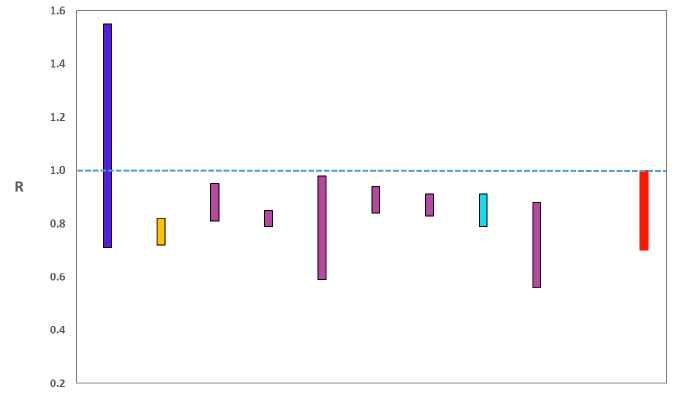
Source: Scientific Advisory Group for Emergencies (SAGE).
The various groups which report to the Scientific Pandemic Influenza Group on Modelling (SPI-M) use different sources of data in their models to produce estimates of incidence (Figure 2). The Scottish Government results this week have been computed using a platform called Epidemia (see Technical Annex in issue 37) which expands the Bayesian semi‑mechanistic model which the Scottish Government runs. SPI-M's consensus view across these methods, as of 5th May, was that the incidence of new daily infections in Scotland was between 1 and 14 new infections per 100,000. The limits of the range are slightly lower than last week. This equates to between 50 and 800 people becoming infected each day in Scotland.
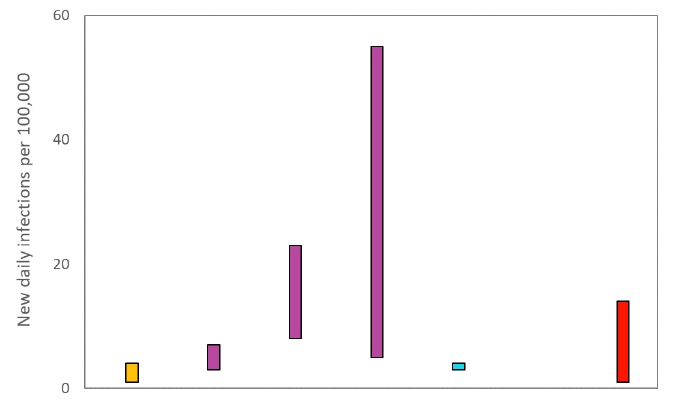
Source: Scientific Pandemic Influenza Group on Modelling (SPI-M).
The consensus from SAGE for this week is that the growth rate in Scotland is between -5% and -2% per day. This is a decrease from 28th April.
What we know about how people's contact patterns have changed
Average contacts are still higher than seen during the lockdown period (averaging around 3 daily contacts) with a current level of 3.9 daily contacts, the highest number of daily contacts reported since the end of December. This has increased by 16% in the last two weeks (comparing surveys pertaining to 8th – 14th April and 22nd -28th April) as seen in Figure 3. Contacts within the work, school and 'other' setting (contacts outside of the school, home or work settings) have increased in the last two weeks with work contacts increasing by 55% and other contacts by 12%. In contrast, mean contacts within the home setting remain at a similar level over the same period.
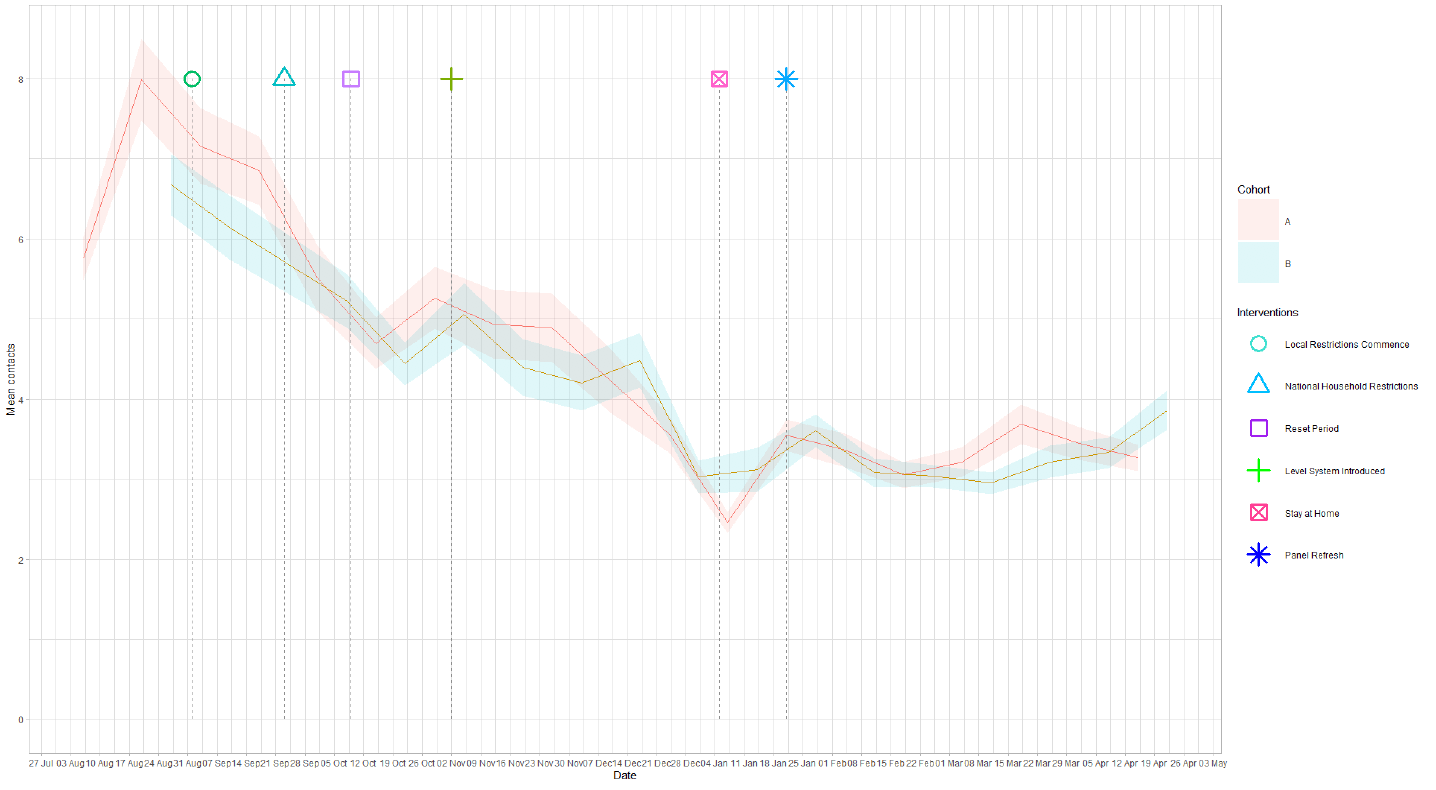
Figure 4 shows how contacts change across age group and setting. Individuals aged 40 and over have increased their contacts in the last two weeks, largely driven by contacts within the work setting for those aged between 40 and 69. Average contacts for those aged under 40 have remained level or have shown a decrease in the last two weeks due to reductions in contacts within the work setting.
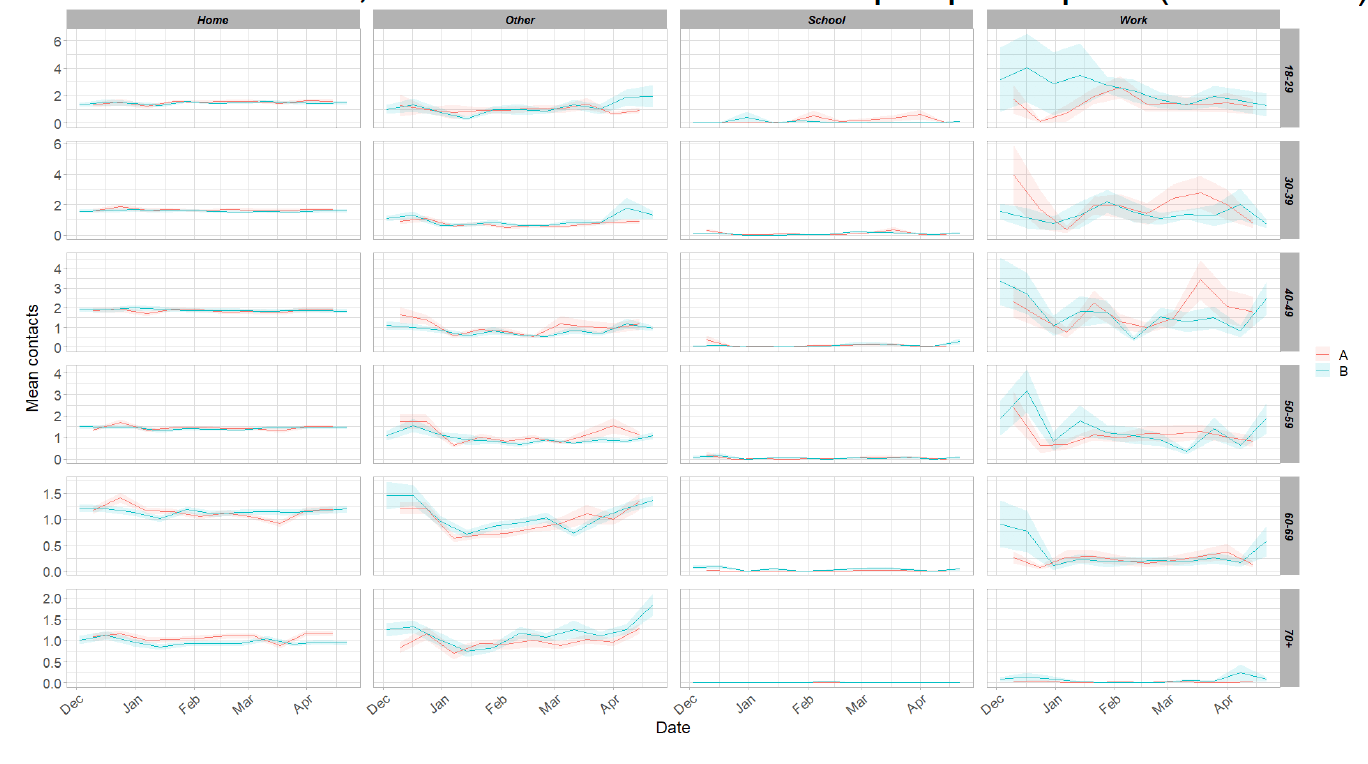
The heatmaps in Figure 5 show the mean overall contacts between age groups for the weeks relating to 8th –14th April and 22nd – 28th April, and the difference between these periods. All age groups have increased their contacts with those aged 18 and under whereas interactions between those aged 18-49 have decreased.
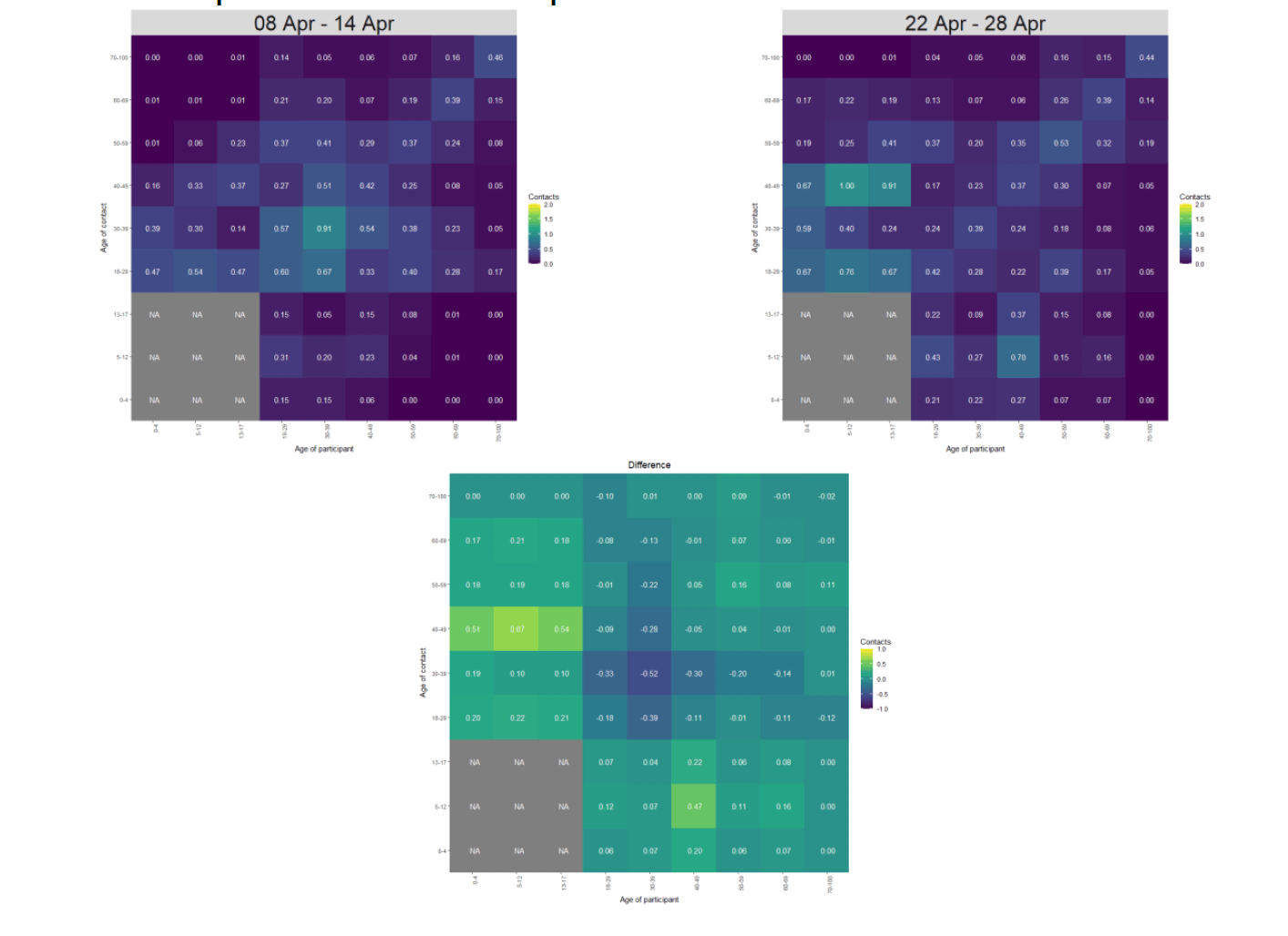
The biggest change in the proportion of participants visiting different locations is seen in those visiting another's home. This is now at a higher level than reported in December (38%). The proportion of participants visiting another's home has increased from 38% to 46% in the last two weeks, with the second largest change reported as attending an event outside, increasing from 65% to 70%.
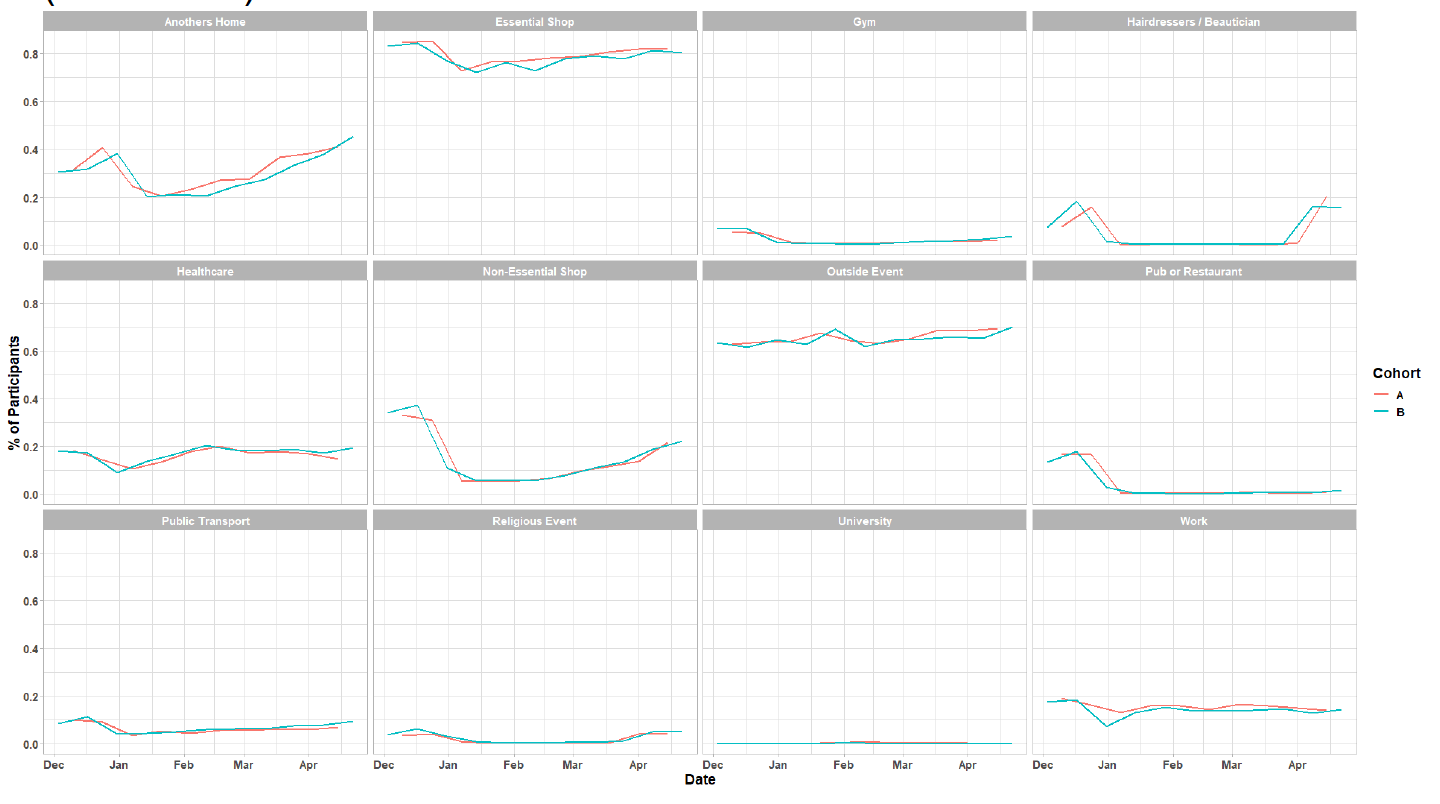
Vaccinations and contacts patterns
From Figure 7, it can be seen that where contacts have remained consistent or even increased for the older age groups, cases and deaths have decreased. This coincides with the increasing number of vaccinations supplied to the population.
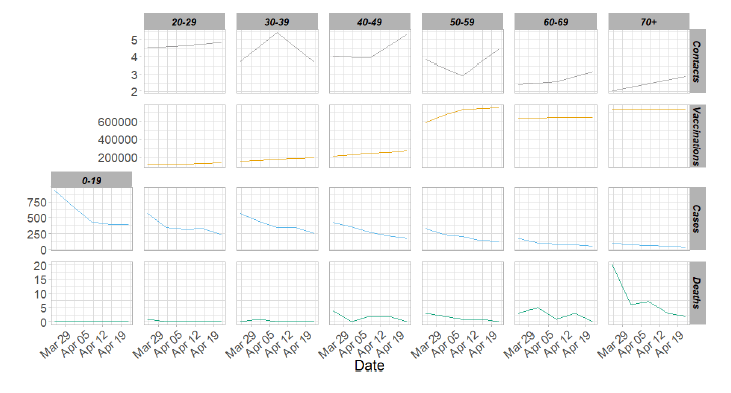
What the modelling tells us about estimated infections as well as Hospital and ICU bed demand
The Scottish Government assesses the impact of Covid-19 on the NHS in the next few weeks in terms of estimated number of infections. For more on how we do this see page 4 of Issue 1 of the Research Findings[3]. Figure 8 shows two projections[4] which take account of compliance and behaviour (better and worse[5]).
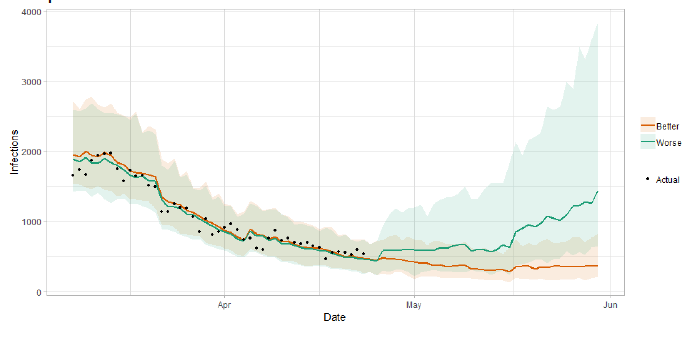
Figure 9 shows the impact of the projections on the number of people in hospital. The modelling includes all hospital stays, whereas the actuals only include stays up to 28 days duration which are linked to Covid-19. Work is ongoing to show the modelled occupancy for stays up to a 28 day limit.
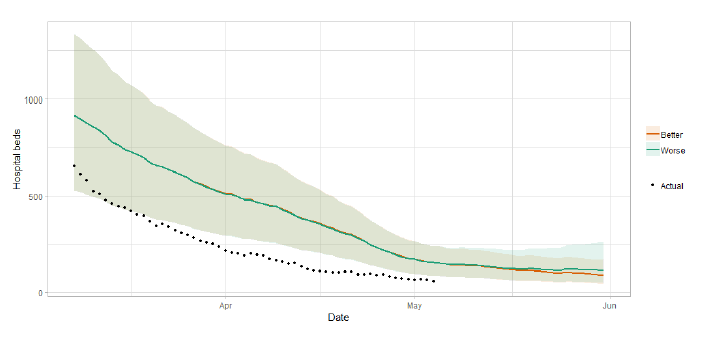
Figure 10 shows the impact of the projection on ICU bed demand.
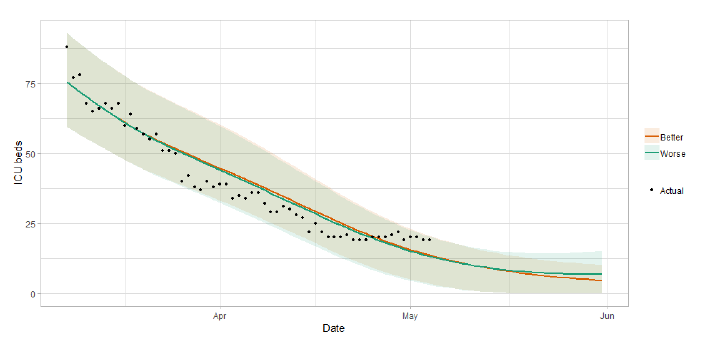
A comparison of the actual data against historical projections is included in the Technical Annex.
What the modelling tells us about projections of hospitalisations and deaths in the medium term
SAGE produces projections of the epidemic[8] (Figure 11), combining estimates from several independent models (including the Scottish Government's logistics modelling, as shown in Figures 8-10). These projections are not forecasts or predictions. They represent a scenario in which the trajectory of the epidemic continues to follow the trends that were seen in the data up to 3 May.
Modelling groups have used data from contact surveys, previous findings[9] and their own expert judgement to incorporate the impact of re‑opening schools and the Easter holidays on transmission. The projections do not include the effects of any other future policy or behavioural changes.
The delay between infection, developing symptoms, the need for hospital care, and death means they will not fully reflect the impact of behaviour changes in the two to three weeks prior to 3 May. Projecting forwards is difficult when the numbers of cases, admissions and deaths fall to very low levels, which can result in wider credible intervals reflecting greater uncertainty. The interquartile range can be used, with judgement, as the projection from which estimates may be derived for the next four weeks, albeit at lower confidence than the 90% credible interval.
These projections include the potential impact of vaccinations over the next four weeks. Modelling groups have used their expert judgement and evidence from Public Health England, Scottish universities, Public Health Scotland and other published studies when making assumptions about vaccine effectiveness.
Beyond two weeks, the projections become more uncertain with greater variability between individual models. This reflects the large differences that can result from fitting models to different data streams, and the influence of small deviations in estimated growth rates and current incidence.
We are not projecting the numbers of people expected to die with Covid‑19 this week. The number of daily deaths has fallen to very low levels over recent weeks. Projecting forwards is difficult when numbers fall to very low levels, therefore SPI-M-O have decided to pause producing medium term projections for daily deaths in Scotland. SPI‑M‑O's consensus view is that the number of deaths will remain very low over the next four weeks.
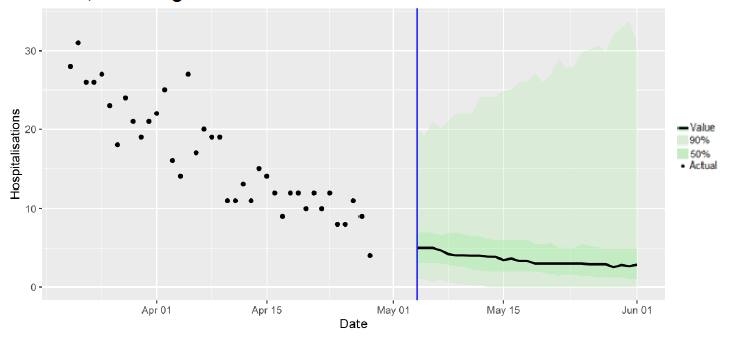
What the modelling tells us about whether Covid-19 infections exceeded what would be expected at this stage in the epidemic
Exceedance indicates whether the number of confirmed infections (based on testing) in each local authority area exceeds the number that was expected. Numbers of positive tests recorded each day, adjusted for population of each local authority and number of cases seen in preceding weeks, should fall within a certain distribution of values, which will rise and fall depending on the number of cases being seen nationally. Areas where the number of positive test results fall beyond the upper 95th percentile of this distribution may be at risk of seeing increased local transmission of Covid-19 and heightened vigilance may be required. This happens when the cumulative exceedance is higher than 6.0. See the Technical Annex in issue 47 for more information.
Figures 12 and 13 show exceedance for local authority areas. Recent cumulative exceedance highlights Dumfries and Galloway (exceedance = 7.38), Moray (5.57), East Renfrewshire (4.93), East Dunbartonshire (4.26), Edinburgh (4.07) and Borders (3.75) as areas of higher risk of transmission.
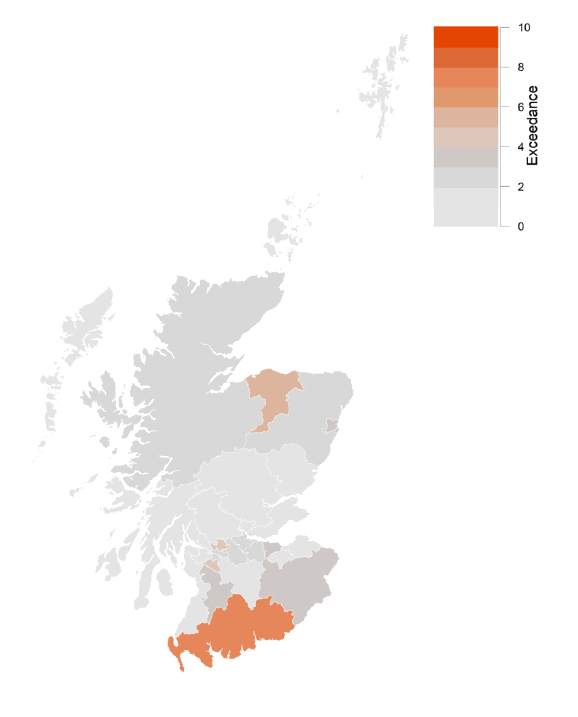
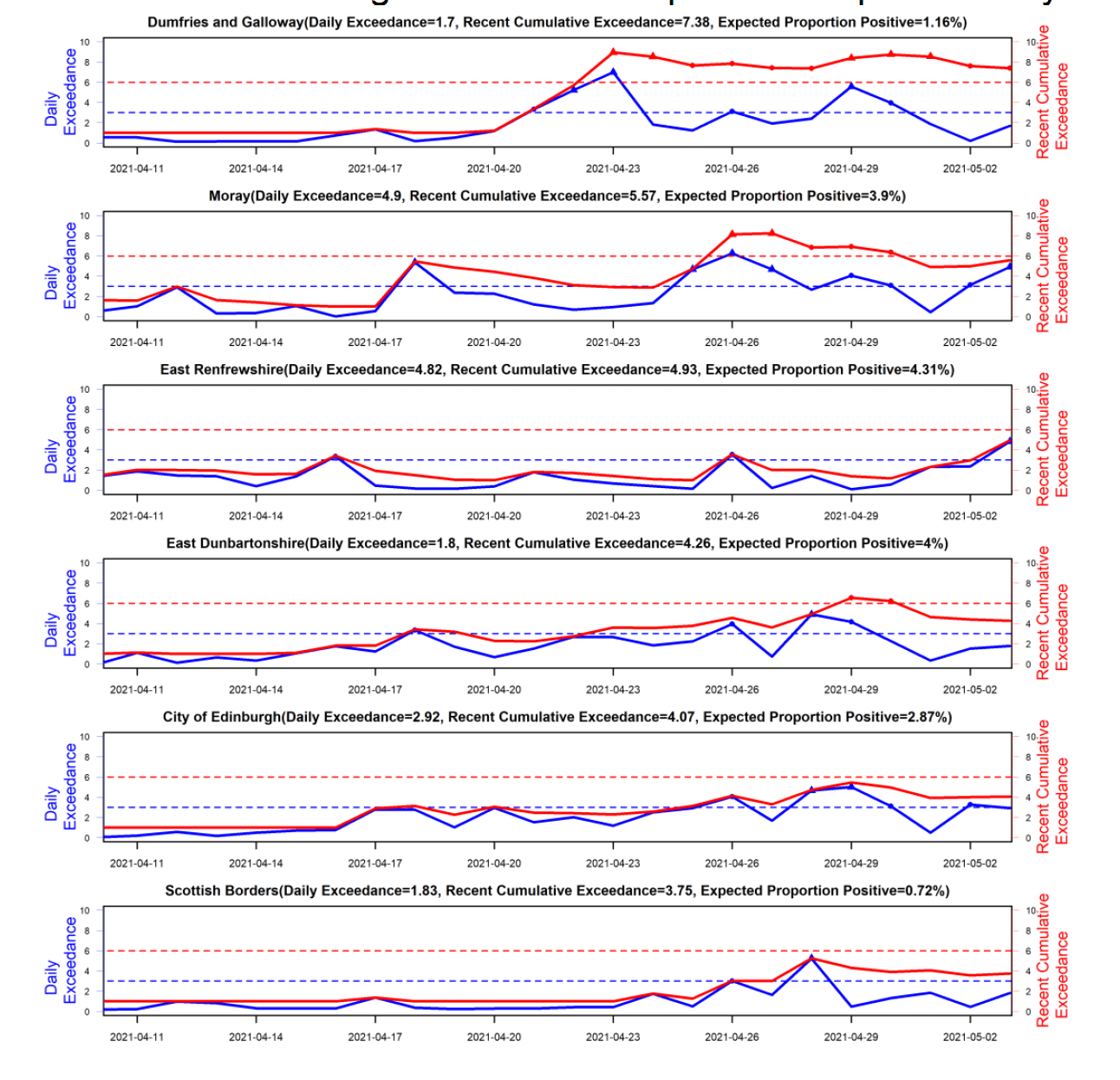
What we know about which local authorities are likely to experience high levels of Covid-19 in two weeks' time
We are using modelling based on Covid-19 cases and deaths from several academic groups to give us an indication of whether a local authority is likely to experience high levels of Covid-19 in the future. This has been compiled via SPI-M into a consensus. In this an area is defined as a hotspot if the two week prediction of cases (positive tests) per 100K population are predicted to exceed a threshold, e.g. 500 cases.
Modelled rates per 100K (Figure 14) indicate that for the week commencing 16 May 2021, no local authorities have at least a 75% probability of exceeding 50 cases. This is the same as last week. Please note that the local estimates should be interpreted with caution as they are based on fewer models than previous reports.
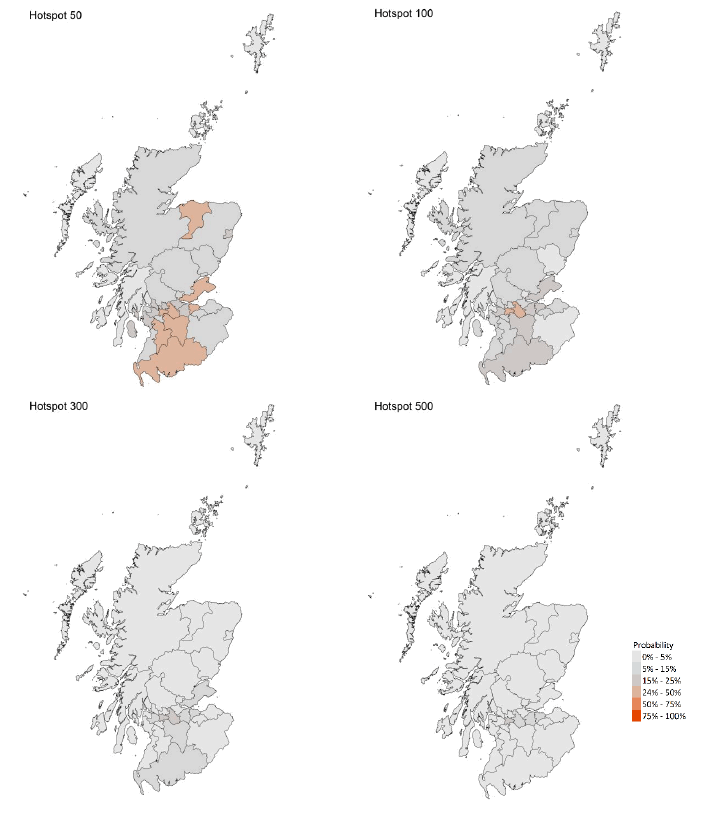
What can analysis of wastewater samples tell us about local outbreaks of Covid-19 infection?
Levels of Covid-19 in wastewater collected at 106 sites around Scotland are adjusted for population and local changes in intake flow rate and compared to daily 7-day average positive case rates derived from Local Authority and Neighbourhood (Intermediate Zone) level aggregate data. See Technical Annex in Issue 34 of these Research Findings for the methodology. The Technical Annex in this issue gives more information about how wastewater is collected, analysed and how this has developed over time.
No new samples were analysed, and few were collected in the week commencing 19th April. Using the new data obtained this week, we observe that wastewater (WW) Covid-19 levels continued their slow decline in much of Scotland.
Figure 15 shows the national aggregate for the original 28 sites with long-term records. This also shows, from January 2021, the aggregate for the full set of up to 106 currently sampled sites in green. In both cases, we exclude an anomalous February reading from Seafield, Edinburgh – see issue 40 for details. Both sets of sites show a decline in wastewater Covid-19 readings from two weeks ago, down approximately 25%.
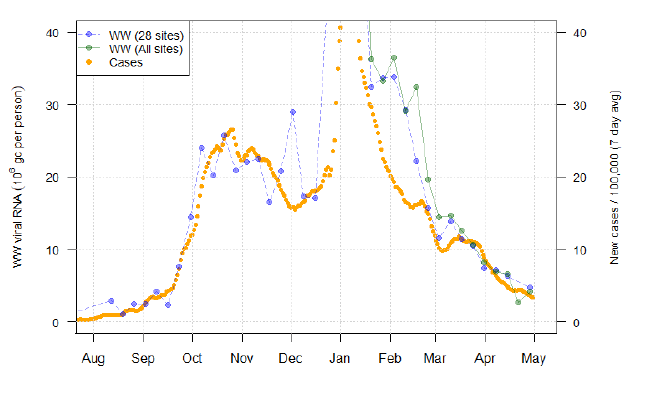
As previously reported, readings in large sites which were not fully adjusted for dilution due to the unavailability of flow or ammonia data. While in some cases this was available, for the large site of Dalmuir (Figure 16) we still lack data. However, Figure 16 does indicate that two additional measurements of WW Covid taken last week showed significantly lower levels. This suggests a continuation of the declining trend in wastewater virus, in line with results for case rates. In the future, the normalisation procedure may be refined in the absence of data to better adapt to changing seasonal weather conditions (see the Technical Annex for more on the normalisation procedure).
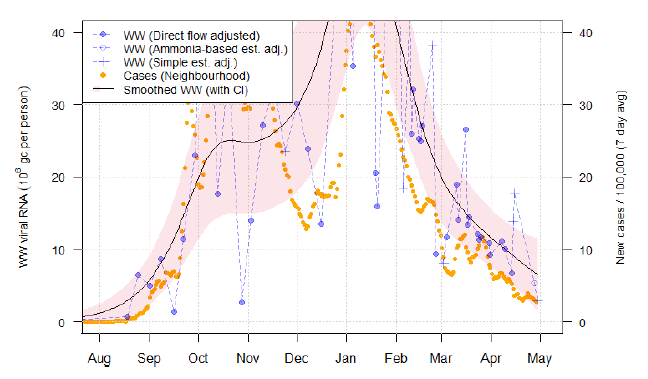
Figure 17 shows the results for Seafield in Edinburgh, the largest site in terms of population, where WW Covid levels are much lower now than a month ago.
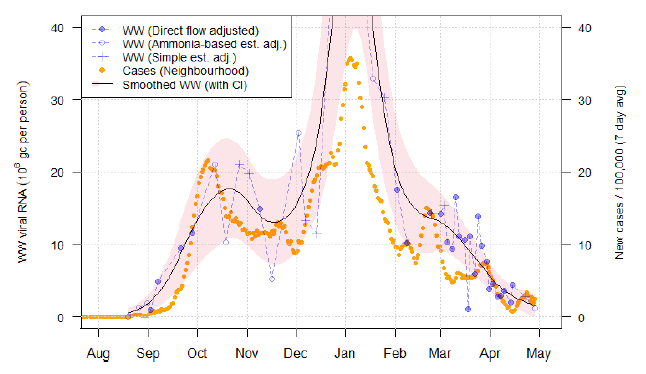
Following up on two smaller sites covered in recent issues of this report, East Calder in West Lothian, and Largs in North Ayrshire, levels of WW Covid-19 and cases in those locations (Figures 18 and Figure 19 respectively) are now much smaller than they previously were. In East Calder, number of cases and WW Covid-19 level rose and fell by roughly similar amounts, while in Largs, WW Covid-19 rose much higher than cases. However, this rise and decline in WW Covid-19 did correspond in terms of timing to a temporary rise in number of cases. It is noticeable that both sites still continue to show small but non-zero levels of WW Covid-19.
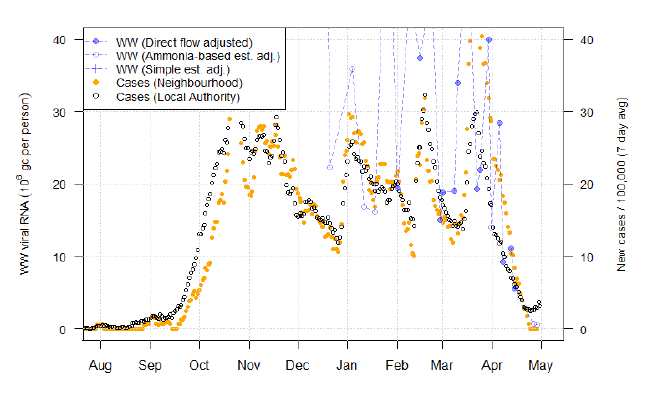
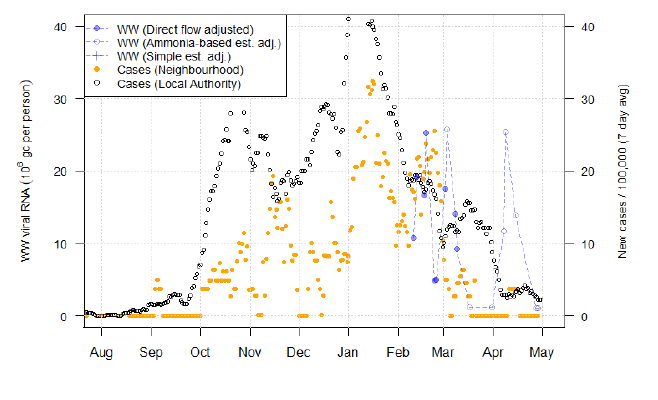
What next?
The Scottish Government continues to work with a number of academic modelling groups to develop other estimates of the epidemic in Scotland.
The modelled estimates of the numbers of new cases and infectious people will continue to be provided as measures of the epidemic as a whole, along with measures of the current point in the epidemic such as Rt and the growth rate. Further information can be found at https://www.gov.scot/coronavirus-covid-19.
Analysis from the EAVE 2 group, which tells us about the pattern of demographics and clinical risk groups over time for those who are testing positive with Covid-19, will be provided in future issues.
Contact
There is a problem
Thanks for your feedback